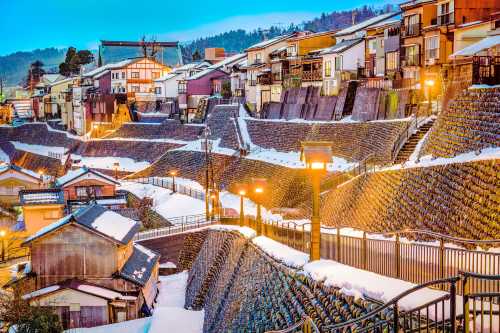Popular Trip Moments
Toyama Prefectural Museum – Free Art, Rooftop Playgrounds & Design Delights | 🌊🚉【Toyama - Roadside Station Amaharashi】 | 😎 Why Toyama Deserves More Than a Day | Toyama's must-try specialty: Black Ramen at Menya Iroha CiC Store | Hotel Vischio Toyama: Just a Turn Away from Toyama Station! | A Day of Art & Nature in Toyama🌊 | Toyama Glass Art Museum Travel Guide for Dragon Boat Festival | #Hokuriku #TateyamaKurobe🇯🇵 I didn’t expect the reservoir sightseeing water release to be so beautiful! | Art Exchange at Toyama Prefectural Museum of Art on Dragon Boat Festival | Art tour of Toyama Art Museum and Togan Canal Park 🎨🌿 | Toyama Castle Ruins Tour during the Dragon Boat Festival 🏰🌸 | Historical Tour of Toyama Castle Ruins 🏰🌳 | Explore the art journey of Toyama Art Museum 🎨✨ | Art & Airy Spaces in Toyama – A Creative Day Surrounded by Beauty | Toyama: Gateway to the Northern Alps and Nature’s Quiet Majesty | Toyama City Black Ramen and Specialty Review! | จุดถ่ายรูป Japan Alps สุดอลังเมืองโทยาม่า🗻🎌 | Recommended good hotel in Toyama City, Hotel JAL City Toyama🏨 | The Most Beautiful and Romantic Starbucks store with Cherry Blossom! 🌸 | 🌸Let's take a look at the beautiful cherry blossoms along the Matsukawa Canal in Toyama City. | Sway Coffee Roaster คาเฟ่มินิมอลเมืองโทยาม่า | Matsukawa River Cafe คาเฟ่น่านั่งริมน้ำมัตซึกาวะ | [Etchu Sakuramachi Seasickness: Toyama City, Toyama Prefecture] | [Toyama Glass Art Museum] | 8 places to visit in Toyama with a stunning view of the Japan Alps 🗻🌸🎌 | Panoramic Petals: Springtime Serenity at Kurehayama Park | Celebrating Earth’s Treasure | Fresh Fish Uohiro-Toyama Bay Shokudo, a seafood restaurant serving fresh fish dishes | One of the Starbucks with the most beautiful view in Toyama🌸🎌 | Japan • Hokuriku | Three-Day Tour of Kanazawa and Toyama
Recommended Attractions at Popular Destinations
Bangkok attraction near me | Manila attraction near me | Tokyo attraction near me | Taipei attraction near me | Hong Kong attraction near me | Seoul attraction near me | Kuala Lumpur attraction near me | Los Angeles attraction near me | Shanghai attraction near me | New York attraction near me | Shenzhen attraction near me | Osaka attraction near me | Singapore attraction near me | London attraction near me | Guangzhou attraction near me | San Francisco attraction near me | Beijing attraction near me | Macau attraction near me | Bali attraction near me | Jakarta attraction near me | Paris attraction near me | Ho Chi Minh City attraction near me | Istanbul attraction near me | Phuket attraction near me | Chicago attraction near me | Seattle attraction near me | Toronto attraction near me | Orlando attraction near me | Cebu attraction near me | Chiang Mai attraction near me
Popular Attractions
Wuzhen | National Gallery Singapore | Taman Safari Bali | Big Ben | Bund Sightseeing Tunnel | Ubud Palace | Chaotianmen Square | Dolby Theatre | Huanglong National Scenic Area | Snow Abu Dhabi | Palm Jumeirah | Atlantis the Palm, Dubai | Sea World | Kowloon | Sochi Olympic Park | Villa del Balbianello | Dubai Aquarium & Underwater Zoo | Fokir Chand Sardar Bari | Capela São Marcos ( Paróquia Nossa Senhora da Guia - Diocese de Franca) | Nineteen on the Park | Gordon L. Hassig Senior Park | Church of St. Michael the Archangel | Masjid Al-Muwahidin Manonjaya | I Love Gorakhpur | Andrés Jiménez Díaz Park | Pocharam Dam Reservoir | Bastenauer Weiher | Window of the World | Sa Pa | Palace of Versailles
Popular Restaurants in Toyama
Izakaya Dai | Daishogun Ekimae | Daishogunoizumi | Toyama Hakobune | Cafe in the Park | Gomangoku, Honten | Cave Yunoki | Starbucks Coffee - Toyama Kansui Park | Rico Monte | Yakiniku House Daishogun Sakuragicho | SYMPOSIUM | Sushiei | Sushi Eihanayagi | Ana Crowne Plaza Hotel Toyama Astral Sky Bar | Sushidama, Toyama Station | La BOMBANCE Kansuikoen | Shiroebiteitoyama | DRAGON RED RIVER Toyamaekimaeten | Marutakaya | Toyamazushi Toyama Airport | Robatayaki Hyottoko | CAFE CONTRAIL | DoubleTree by Hilton Toyama | Sushi Gekijyo Tottotoyareya | BACCHUS | Kitokitohagiwara | KAIMARE | Kusunoki | Fukuya | Hanayorisakana
Popular Ranked Lists
Popular Local Restaurants in Shanghai | Top 19 Best Things to Do in Dali | Popular Local Restaurants in Kyoto | Popular Best Things to Do in Shelby County | Popular Luxury Hotels in Oslo County | Popular Must-Visit Restaurants in Florence | Top 3 Luxury Hotels in Al Madinah | Popular Best Things to Do in Otero County | Popular Luxury Hotels in Kieni East | Top 19 Local Restaurants in Singapore | Top 19 Light Bites in Singapore | Popular Best Things to Do in Changting | Popular Best Things to Do in Erie County | Top 8 Best Things to Do in Fulton County | Popular Local Restaurants in Beijing | Top 7 Best Things to Do in Harris County | Popular Best Things to Do in DeKalb County | Popular Luxury Hotels Near Montelimar | Popular Luxury Hotels in Nizwa | Top 20 Local Restaurants in Koh Samui | Popular Luxury Hotels in Fes-Meknes | Popular Must-Visit Restaurants in Osaka | Popular Local Restaurants in Bangkok | Top 8 Luxury Hotels in Hurghada | Top 8 Best Things to Do in Niagara Falls | Popular Premium Hotels Near Geraldine | Popular Luxury Hotels in Kathmandu | Popular Luxury Hotels in Astana | Top 20 Local Restaurants in Nanjing | Popular Luxury Hotels Near Fort William
Payment Methods
Our Partners
Copyright © 2025 Trip.com Travel Singapore Pte. Ltd. All rights reserved
Site Operator: Trip.com Travel Singapore Pte. Ltd.
Site Operator: Trip.com Travel Singapore Pte. Ltd.























